Accounting for Decision Making: Crystal Hotel Pty Ltd Financial Report
VerifiedAdded on 2023/01/11
|8
|1661
|95
Report
AI Summary
This report presents a comparative financial analysis of Crystal Hotel Pty Ltd against industry averages, utilizing vertical and ratio analysis techniques. The report assesses the company's performance in profitability, efficiency, liquidity, and solvency, highlighting areas of strength and weakness. It analyzes key financial benchmarks such as revenue, cost of sales, and personnel costs, offering recommendations for improvement, including strategies to enhance accommodation, manage personnel costs, and improve liquidity. The analysis also includes a discussion of relevant financial ratios, such as profitability, efficiency, liquidity, and solvency ratios. Furthermore, the report suggests additional industry-specific benchmarks for Crystal Hotel Pty Ltd to use in future comparative analyses, such as customer reviews, external investments, and pricing strategies. The conclusion summarizes the importance of accounting for effective operations and sustainable success, acknowledging the company's financial stability for potential renovation or refurbishment projects.
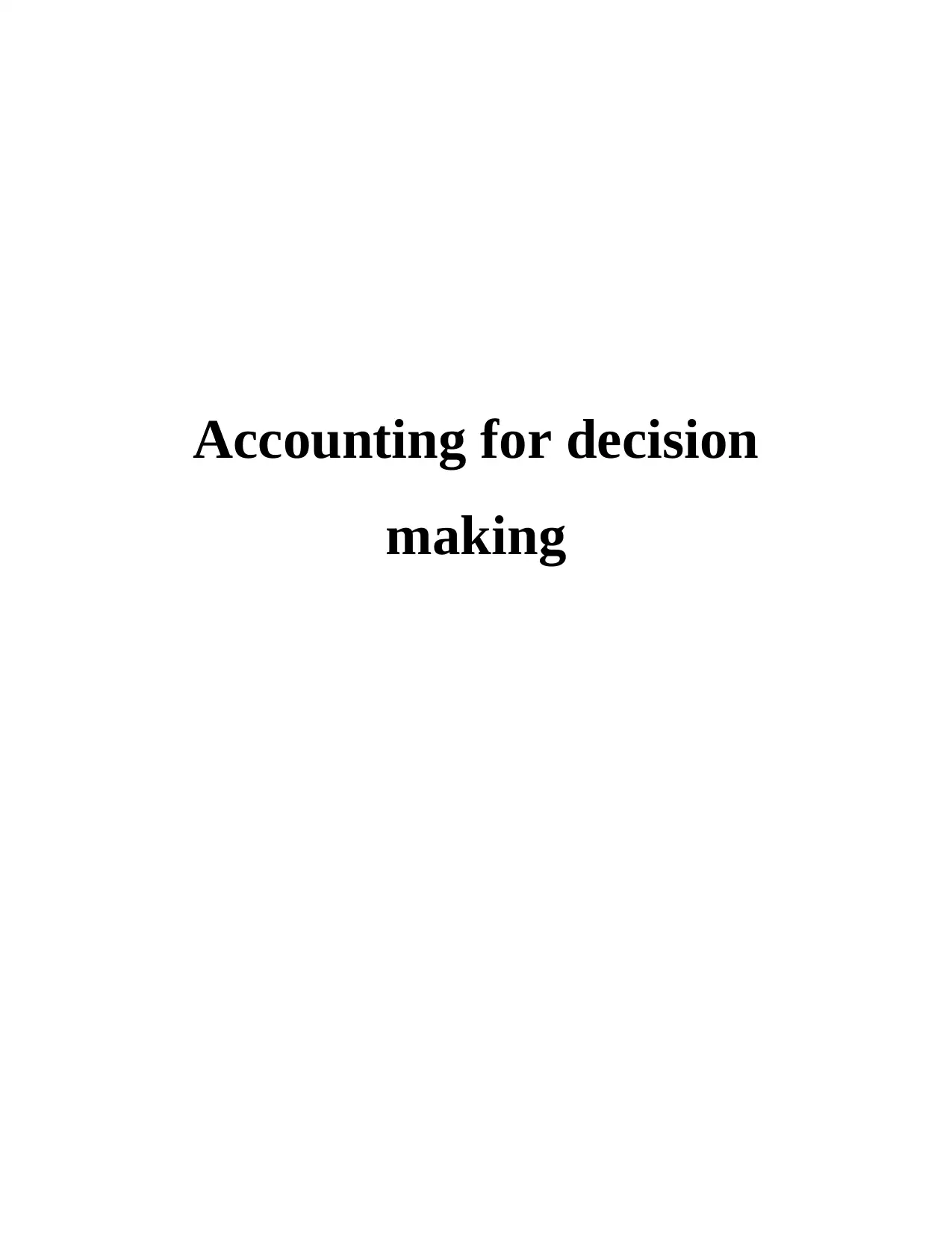
Accounting for decision
making
making
Paraphrase This Document
Need a fresh take? Get an instant paraphrase of this document with our AI Paraphraser
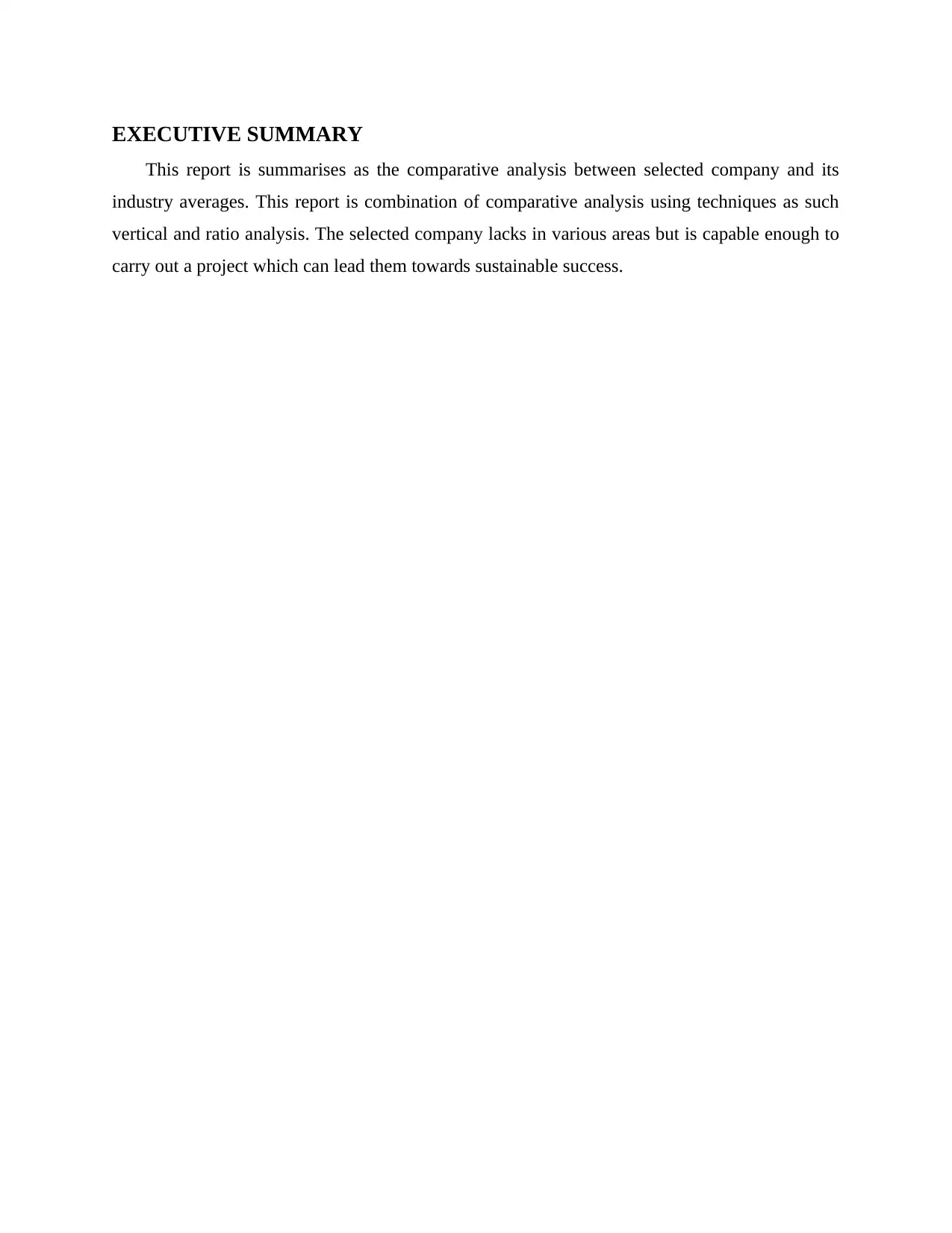
EXECUTIVE SUMMARY
This report is summarises as the comparative analysis between selected company and its
industry averages. This report is combination of comparative analysis using techniques as such
vertical and ratio analysis. The selected company lacks in various areas but is capable enough to
carry out a project which can lead them towards sustainable success.
This report is summarises as the comparative analysis between selected company and its
industry averages. This report is combination of comparative analysis using techniques as such
vertical and ratio analysis. The selected company lacks in various areas but is capable enough to
carry out a project which can lead them towards sustainable success.
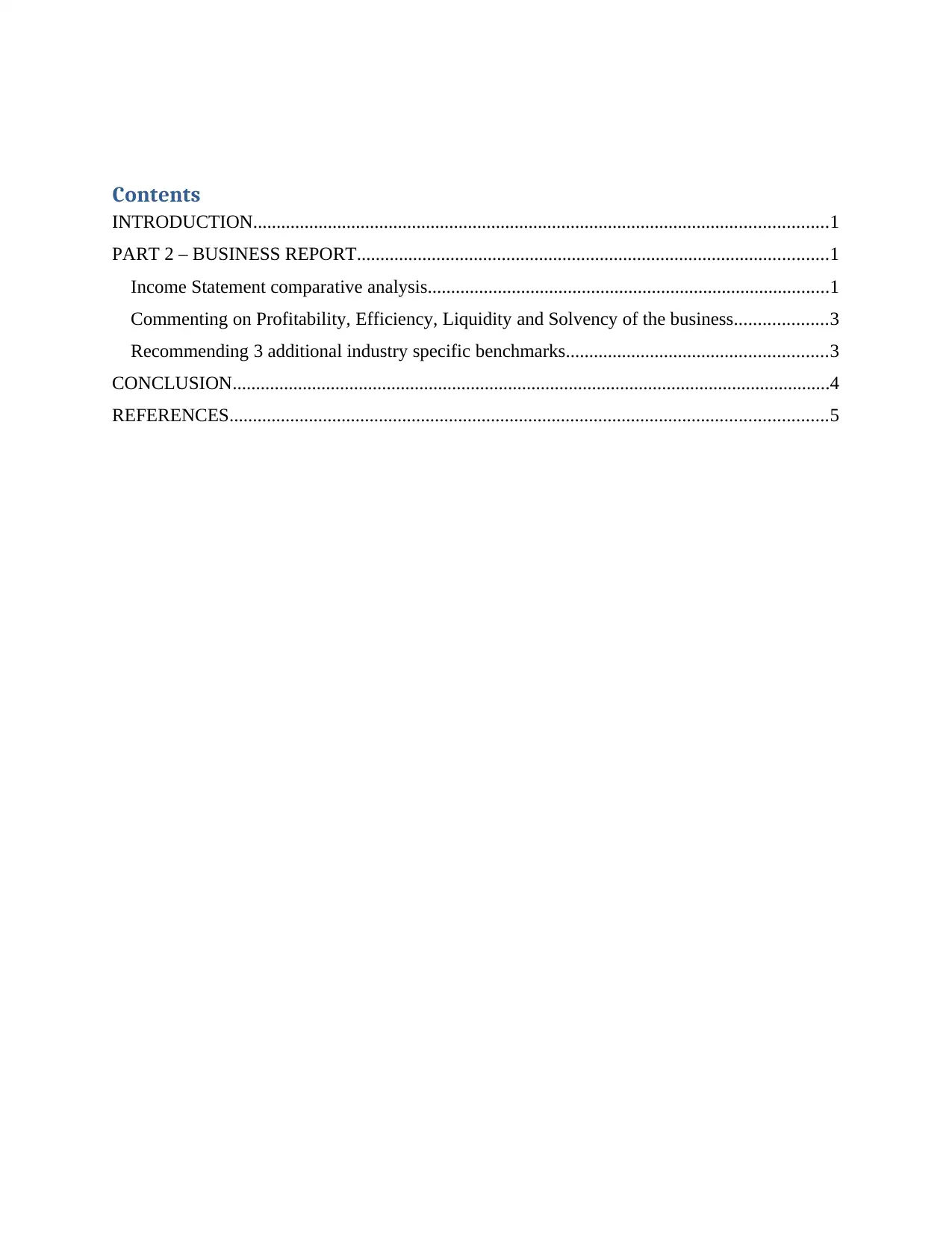
Contents
INTRODUCTION...........................................................................................................................1
PART 2 – BUSINESS REPORT.....................................................................................................1
Income Statement comparative analysis......................................................................................1
Commenting on Profitability, Efficiency, Liquidity and Solvency of the business....................3
Recommending 3 additional industry specific benchmarks........................................................3
CONCLUSION................................................................................................................................4
REFERENCES................................................................................................................................5
INTRODUCTION...........................................................................................................................1
PART 2 – BUSINESS REPORT.....................................................................................................1
Income Statement comparative analysis......................................................................................1
Commenting on Profitability, Efficiency, Liquidity and Solvency of the business....................3
Recommending 3 additional industry specific benchmarks........................................................3
CONCLUSION................................................................................................................................4
REFERENCES................................................................................................................................5
⊘ This is a preview!⊘
Do you want full access?
Subscribe today to unlock all pages.

Trusted by 1+ million students worldwide

INTRODUCTION
Accounting is a concept of recording, analysing and evaluating business transactions so that
relevant decisions can be taken (Groot and Selto, 2013). The main aim of this report is to build
an understanding about the concepts of accounting and how they can help in attaining business
success. For this purpose, financial information of Crystal Hotel Pty Ltd is acquired using which
a comparative analysis between this business and industry will be done.
In this report, various benchmarks available such as revenue, cost of sales, human resource
costs and other will be used to compare selected company with industry along with which
suitable recommendations to the company will also be provided. Using the ratio analysis
calculated for Crystal Hotel Pty, comments will be given on Profitability, Efficiency, Liquidity
and Solvency of the company. Lastly, few additional benchmarks will be recommended which
selected company can use for effective comparative analysis.
PART 2 – BUSINESS REPORT
Income Statement comparative analysis
How the business is performing compared to industry
Among the various vertical analyses provided of the industry, vertical analysis of
industry of hotels comprising more than 150 rooms of 2018 will be considered as Crystal Hotel
Pty Ltd also has 160 rooms. Similar to the industry, selected company also gains approximately
half of its revenues from rooms (accommodation) as events are occasional in this industry. Net
profit percentage over its revenue is 39 for this industry but the selected company only manages
to record 12.98% of net profit against revenue. This implies that the selected company is not as
capable as other businesses in this industry are to manage their operational expenses.
Revenue
This benchmark is the most important barometer for a business (Mihăilă, 2014). From the
vertical analysis statement of the industry it can be seen that from the entire revenues, 65%
revenues are gained by rooms, 27% by F&B, 3% from halls and 4% from other sources. But as
per the Crystal Hotel Pty Ltd vertical analysis, the majority of this company revenue that is
50.42% comes from rooms, 28.92% from F&B, 16.97% from functions and 3.69% from other
sources. This comparison implies that selected company needs to focus on the accommodation
1
Accounting is a concept of recording, analysing and evaluating business transactions so that
relevant decisions can be taken (Groot and Selto, 2013). The main aim of this report is to build
an understanding about the concepts of accounting and how they can help in attaining business
success. For this purpose, financial information of Crystal Hotel Pty Ltd is acquired using which
a comparative analysis between this business and industry will be done.
In this report, various benchmarks available such as revenue, cost of sales, human resource
costs and other will be used to compare selected company with industry along with which
suitable recommendations to the company will also be provided. Using the ratio analysis
calculated for Crystal Hotel Pty, comments will be given on Profitability, Efficiency, Liquidity
and Solvency of the company. Lastly, few additional benchmarks will be recommended which
selected company can use for effective comparative analysis.
PART 2 – BUSINESS REPORT
Income Statement comparative analysis
How the business is performing compared to industry
Among the various vertical analyses provided of the industry, vertical analysis of
industry of hotels comprising more than 150 rooms of 2018 will be considered as Crystal Hotel
Pty Ltd also has 160 rooms. Similar to the industry, selected company also gains approximately
half of its revenues from rooms (accommodation) as events are occasional in this industry. Net
profit percentage over its revenue is 39 for this industry but the selected company only manages
to record 12.98% of net profit against revenue. This implies that the selected company is not as
capable as other businesses in this industry are to manage their operational expenses.
Revenue
This benchmark is the most important barometer for a business (Mihăilă, 2014). From the
vertical analysis statement of the industry it can be seen that from the entire revenues, 65%
revenues are gained by rooms, 27% by F&B, 3% from halls and 4% from other sources. But as
per the Crystal Hotel Pty Ltd vertical analysis, the majority of this company revenue that is
50.42% comes from rooms, 28.92% from F&B, 16.97% from functions and 3.69% from other
sources. This comparison implies that selected company needs to focus on the accommodation
1
Paraphrase This Document
Need a fresh take? Get an instant paraphrase of this document with our AI Paraphraser
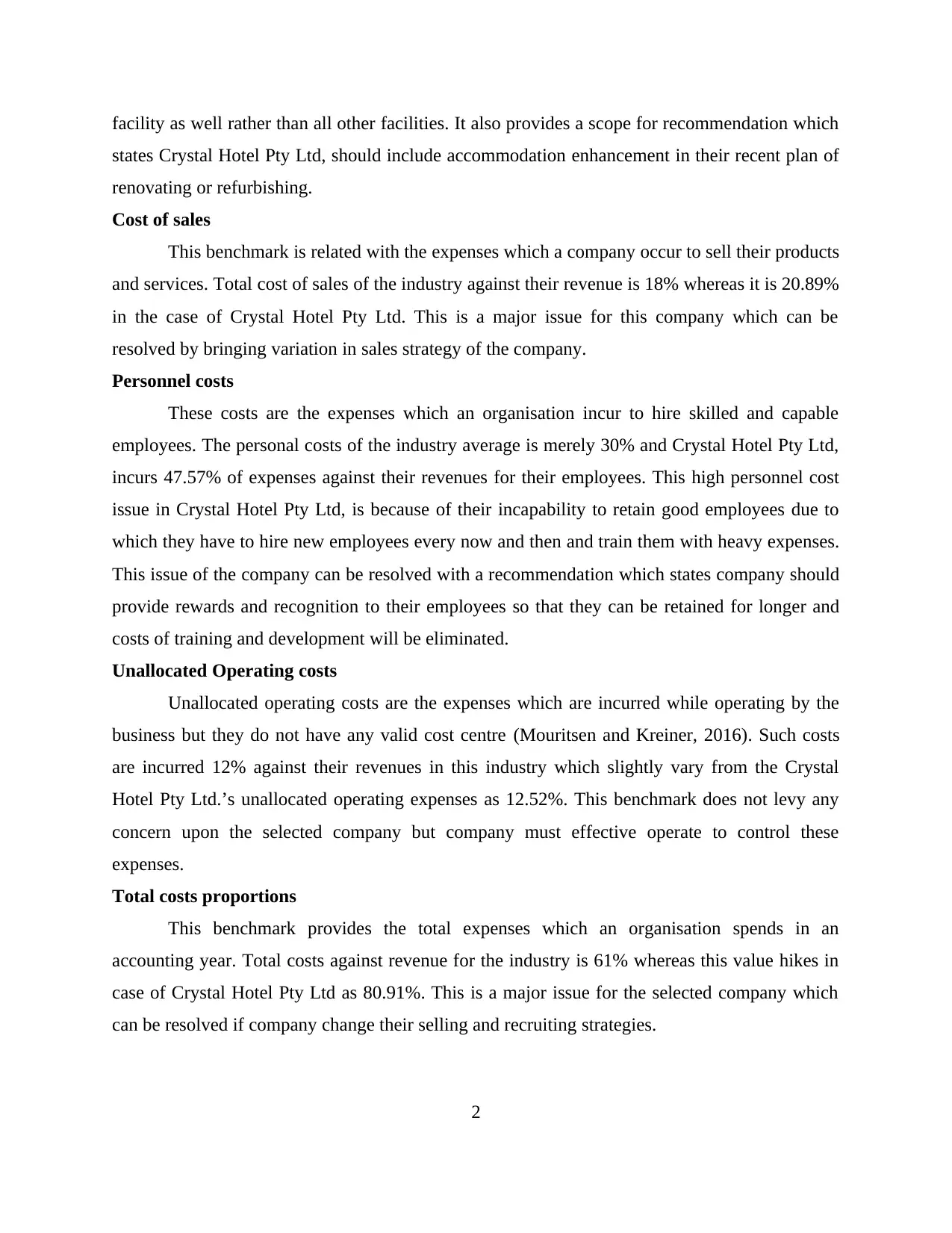
facility as well rather than all other facilities. It also provides a scope for recommendation which
states Crystal Hotel Pty Ltd, should include accommodation enhancement in their recent plan of
renovating or refurbishing.
Cost of sales
This benchmark is related with the expenses which a company occur to sell their products
and services. Total cost of sales of the industry against their revenue is 18% whereas it is 20.89%
in the case of Crystal Hotel Pty Ltd. This is a major issue for this company which can be
resolved by bringing variation in sales strategy of the company.
Personnel costs
These costs are the expenses which an organisation incur to hire skilled and capable
employees. The personal costs of the industry average is merely 30% and Crystal Hotel Pty Ltd,
incurs 47.57% of expenses against their revenues for their employees. This high personnel cost
issue in Crystal Hotel Pty Ltd, is because of their incapability to retain good employees due to
which they have to hire new employees every now and then and train them with heavy expenses.
This issue of the company can be resolved with a recommendation which states company should
provide rewards and recognition to their employees so that they can be retained for longer and
costs of training and development will be eliminated.
Unallocated Operating costs
Unallocated operating costs are the expenses which are incurred while operating by the
business but they do not have any valid cost centre (Mouritsen and Kreiner, 2016). Such costs
are incurred 12% against their revenues in this industry which slightly vary from the Crystal
Hotel Pty Ltd.’s unallocated operating expenses as 12.52%. This benchmark does not levy any
concern upon the selected company but company must effective operate to control these
expenses.
Total costs proportions
This benchmark provides the total expenses which an organisation spends in an
accounting year. Total costs against revenue for the industry is 61% whereas this value hikes in
case of Crystal Hotel Pty Ltd as 80.91%. This is a major issue for the selected company which
can be resolved if company change their selling and recruiting strategies.
2
states Crystal Hotel Pty Ltd, should include accommodation enhancement in their recent plan of
renovating or refurbishing.
Cost of sales
This benchmark is related with the expenses which a company occur to sell their products
and services. Total cost of sales of the industry against their revenue is 18% whereas it is 20.89%
in the case of Crystal Hotel Pty Ltd. This is a major issue for this company which can be
resolved by bringing variation in sales strategy of the company.
Personnel costs
These costs are the expenses which an organisation incur to hire skilled and capable
employees. The personal costs of the industry average is merely 30% and Crystal Hotel Pty Ltd,
incurs 47.57% of expenses against their revenues for their employees. This high personnel cost
issue in Crystal Hotel Pty Ltd, is because of their incapability to retain good employees due to
which they have to hire new employees every now and then and train them with heavy expenses.
This issue of the company can be resolved with a recommendation which states company should
provide rewards and recognition to their employees so that they can be retained for longer and
costs of training and development will be eliminated.
Unallocated Operating costs
Unallocated operating costs are the expenses which are incurred while operating by the
business but they do not have any valid cost centre (Mouritsen and Kreiner, 2016). Such costs
are incurred 12% against their revenues in this industry which slightly vary from the Crystal
Hotel Pty Ltd.’s unallocated operating expenses as 12.52%. This benchmark does not levy any
concern upon the selected company but company must effective operate to control these
expenses.
Total costs proportions
This benchmark provides the total expenses which an organisation spends in an
accounting year. Total costs against revenue for the industry is 61% whereas this value hikes in
case of Crystal Hotel Pty Ltd as 80.91%. This is a major issue for the selected company which
can be resolved if company change their selling and recruiting strategies.
2
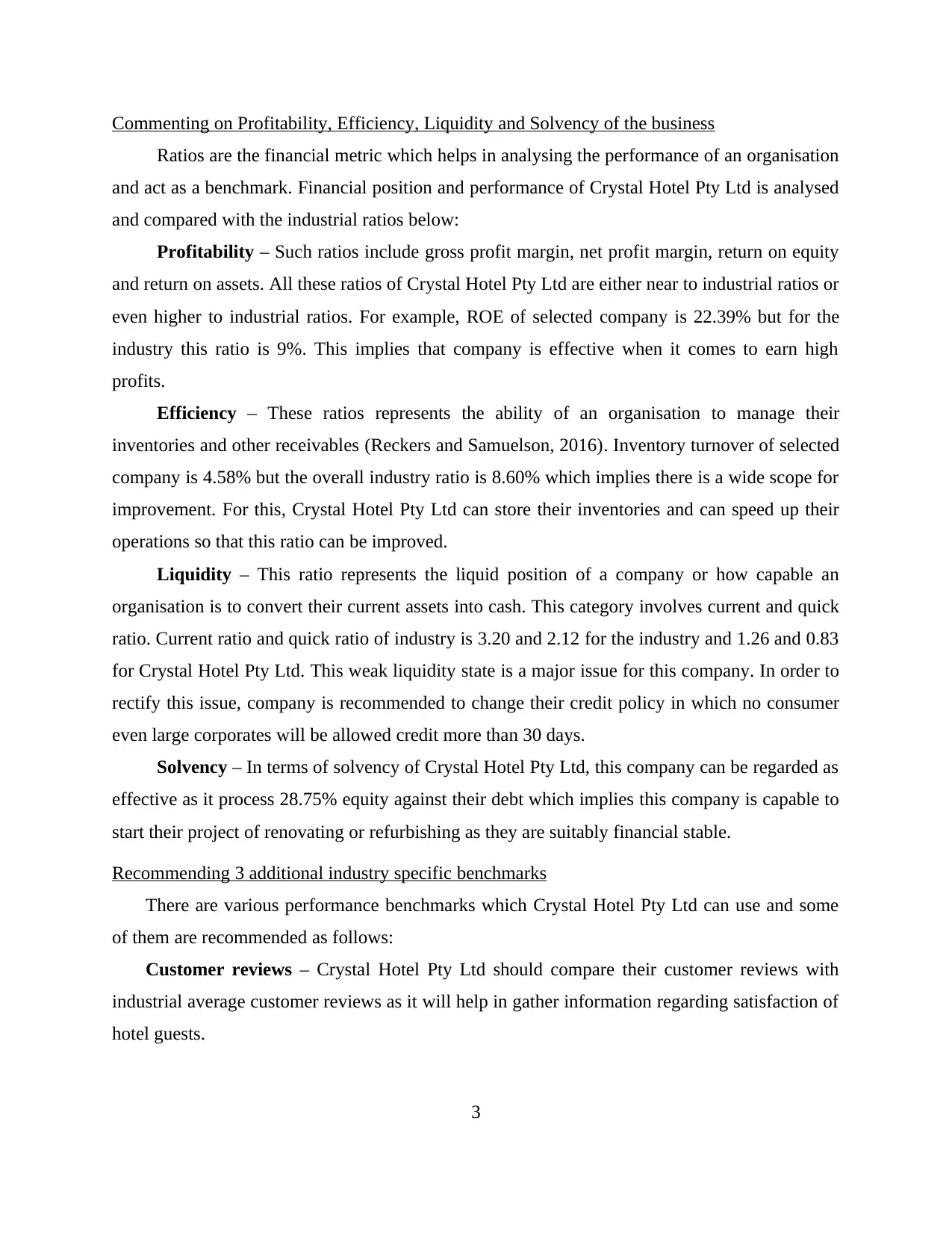
Commenting on Profitability, Efficiency, Liquidity and Solvency of the business
Ratios are the financial metric which helps in analysing the performance of an organisation
and act as a benchmark. Financial position and performance of Crystal Hotel Pty Ltd is analysed
and compared with the industrial ratios below:
Profitability – Such ratios include gross profit margin, net profit margin, return on equity
and return on assets. All these ratios of Crystal Hotel Pty Ltd are either near to industrial ratios or
even higher to industrial ratios. For example, ROE of selected company is 22.39% but for the
industry this ratio is 9%. This implies that company is effective when it comes to earn high
profits.
Efficiency – These ratios represents the ability of an organisation to manage their
inventories and other receivables (Reckers and Samuelson, 2016). Inventory turnover of selected
company is 4.58% but the overall industry ratio is 8.60% which implies there is a wide scope for
improvement. For this, Crystal Hotel Pty Ltd can store their inventories and can speed up their
operations so that this ratio can be improved.
Liquidity – This ratio represents the liquid position of a company or how capable an
organisation is to convert their current assets into cash. This category involves current and quick
ratio. Current ratio and quick ratio of industry is 3.20 and 2.12 for the industry and 1.26 and 0.83
for Crystal Hotel Pty Ltd. This weak liquidity state is a major issue for this company. In order to
rectify this issue, company is recommended to change their credit policy in which no consumer
even large corporates will be allowed credit more than 30 days.
Solvency – In terms of solvency of Crystal Hotel Pty Ltd, this company can be regarded as
effective as it process 28.75% equity against their debt which implies this company is capable to
start their project of renovating or refurbishing as they are suitably financial stable.
Recommending 3 additional industry specific benchmarks
There are various performance benchmarks which Crystal Hotel Pty Ltd can use and some
of them are recommended as follows:
Customer reviews – Crystal Hotel Pty Ltd should compare their customer reviews with
industrial average customer reviews as it will help in gather information regarding satisfaction of
hotel guests.
3
Ratios are the financial metric which helps in analysing the performance of an organisation
and act as a benchmark. Financial position and performance of Crystal Hotel Pty Ltd is analysed
and compared with the industrial ratios below:
Profitability – Such ratios include gross profit margin, net profit margin, return on equity
and return on assets. All these ratios of Crystal Hotel Pty Ltd are either near to industrial ratios or
even higher to industrial ratios. For example, ROE of selected company is 22.39% but for the
industry this ratio is 9%. This implies that company is effective when it comes to earn high
profits.
Efficiency – These ratios represents the ability of an organisation to manage their
inventories and other receivables (Reckers and Samuelson, 2016). Inventory turnover of selected
company is 4.58% but the overall industry ratio is 8.60% which implies there is a wide scope for
improvement. For this, Crystal Hotel Pty Ltd can store their inventories and can speed up their
operations so that this ratio can be improved.
Liquidity – This ratio represents the liquid position of a company or how capable an
organisation is to convert their current assets into cash. This category involves current and quick
ratio. Current ratio and quick ratio of industry is 3.20 and 2.12 for the industry and 1.26 and 0.83
for Crystal Hotel Pty Ltd. This weak liquidity state is a major issue for this company. In order to
rectify this issue, company is recommended to change their credit policy in which no consumer
even large corporates will be allowed credit more than 30 days.
Solvency – In terms of solvency of Crystal Hotel Pty Ltd, this company can be regarded as
effective as it process 28.75% equity against their debt which implies this company is capable to
start their project of renovating or refurbishing as they are suitably financial stable.
Recommending 3 additional industry specific benchmarks
There are various performance benchmarks which Crystal Hotel Pty Ltd can use and some
of them are recommended as follows:
Customer reviews – Crystal Hotel Pty Ltd should compare their customer reviews with
industrial average customer reviews as it will help in gather information regarding satisfaction of
hotel guests.
3
⊘ This is a preview!⊘
Do you want full access?
Subscribe today to unlock all pages.

Trusted by 1+ million students worldwide
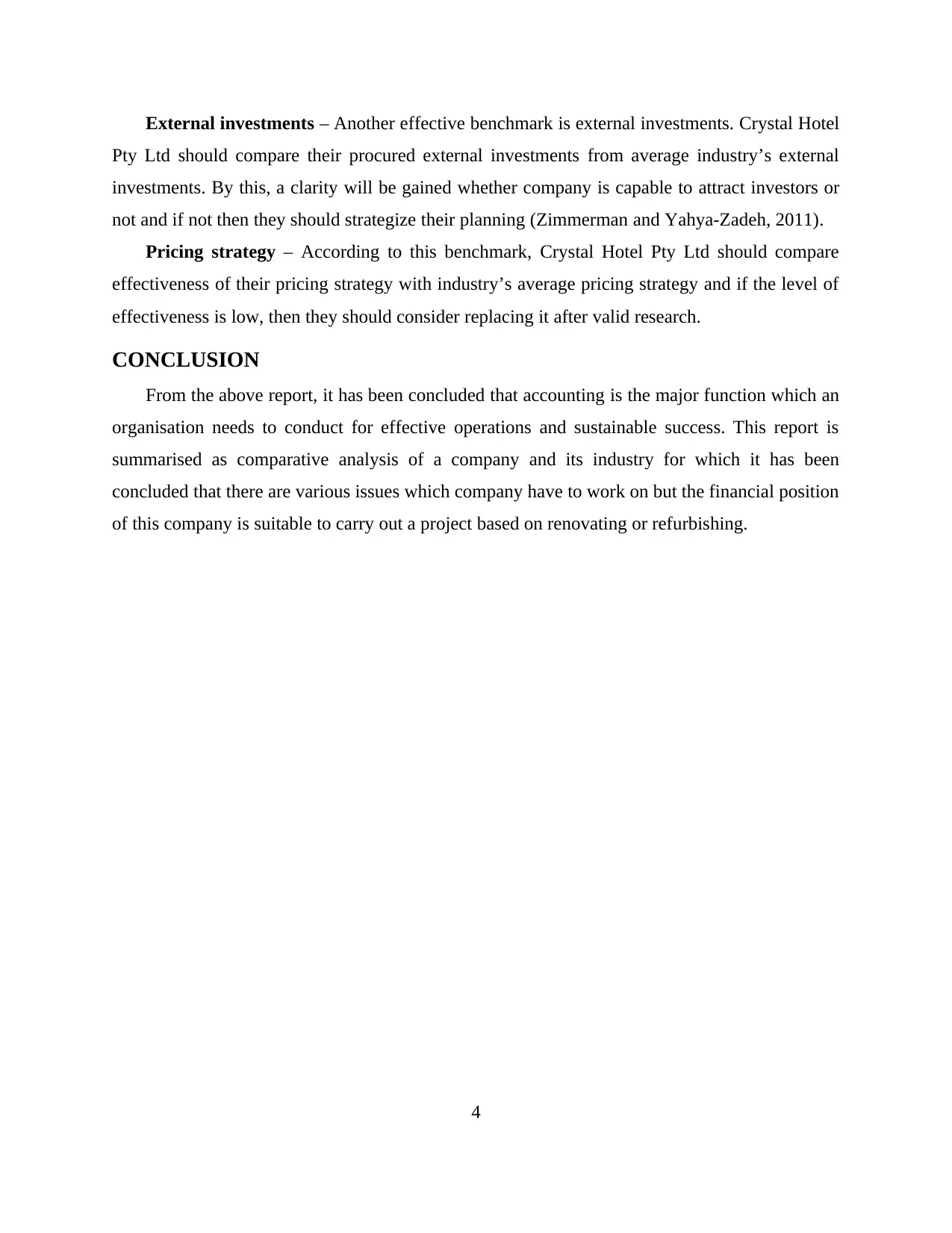
External investments – Another effective benchmark is external investments. Crystal Hotel
Pty Ltd should compare their procured external investments from average industry’s external
investments. By this, a clarity will be gained whether company is capable to attract investors or
not and if not then they should strategize their planning (Zimmerman and Yahya-Zadeh, 2011).
Pricing strategy – According to this benchmark, Crystal Hotel Pty Ltd should compare
effectiveness of their pricing strategy with industry’s average pricing strategy and if the level of
effectiveness is low, then they should consider replacing it after valid research.
CONCLUSION
From the above report, it has been concluded that accounting is the major function which an
organisation needs to conduct for effective operations and sustainable success. This report is
summarised as comparative analysis of a company and its industry for which it has been
concluded that there are various issues which company have to work on but the financial position
of this company is suitable to carry out a project based on renovating or refurbishing.
4
Pty Ltd should compare their procured external investments from average industry’s external
investments. By this, a clarity will be gained whether company is capable to attract investors or
not and if not then they should strategize their planning (Zimmerman and Yahya-Zadeh, 2011).
Pricing strategy – According to this benchmark, Crystal Hotel Pty Ltd should compare
effectiveness of their pricing strategy with industry’s average pricing strategy and if the level of
effectiveness is low, then they should consider replacing it after valid research.
CONCLUSION
From the above report, it has been concluded that accounting is the major function which an
organisation needs to conduct for effective operations and sustainable success. This report is
summarised as comparative analysis of a company and its industry for which it has been
concluded that there are various issues which company have to work on but the financial position
of this company is suitable to carry out a project based on renovating or refurbishing.
4
Paraphrase This Document
Need a fresh take? Get an instant paraphrase of this document with our AI Paraphraser
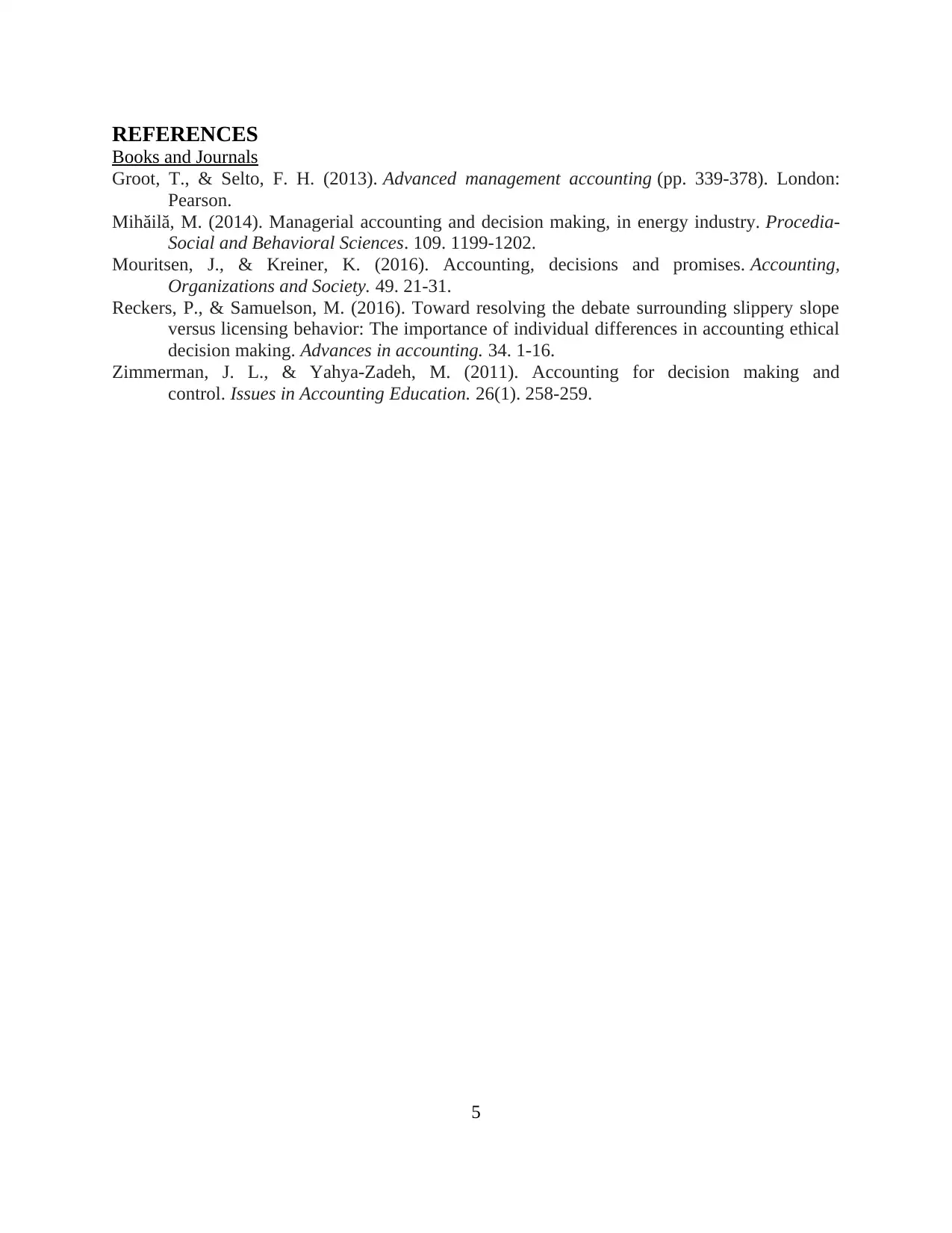
REFERENCES
Books and Journals
Groot, T., & Selto, F. H. (2013). Advanced management accounting (pp. 339-378). London:
Pearson.
Mihăilă, M. (2014). Managerial accounting and decision making, in energy industry. Procedia-
Social and Behavioral Sciences. 109. 1199-1202.
Mouritsen, J., & Kreiner, K. (2016). Accounting, decisions and promises. Accounting,
Organizations and Society. 49. 21-31.
Reckers, P., & Samuelson, M. (2016). Toward resolving the debate surrounding slippery slope
versus licensing behavior: The importance of individual differences in accounting ethical
decision making. Advances in accounting. 34. 1-16.
Zimmerman, J. L., & Yahya-Zadeh, M. (2011). Accounting for decision making and
control. Issues in Accounting Education. 26(1). 258-259.
5
Books and Journals
Groot, T., & Selto, F. H. (2013). Advanced management accounting (pp. 339-378). London:
Pearson.
Mihăilă, M. (2014). Managerial accounting and decision making, in energy industry. Procedia-
Social and Behavioral Sciences. 109. 1199-1202.
Mouritsen, J., & Kreiner, K. (2016). Accounting, decisions and promises. Accounting,
Organizations and Society. 49. 21-31.
Reckers, P., & Samuelson, M. (2016). Toward resolving the debate surrounding slippery slope
versus licensing behavior: The importance of individual differences in accounting ethical
decision making. Advances in accounting. 34. 1-16.
Zimmerman, J. L., & Yahya-Zadeh, M. (2011). Accounting for decision making and
control. Issues in Accounting Education. 26(1). 258-259.
5
1 out of 8
Related Documents
Your All-in-One AI-Powered Toolkit for Academic Success.
+13062052269
info@desklib.com
Available 24*7 on WhatsApp / Email
![[object Object]](/_next/static/media/star-bottom.7253800d.svg)
Unlock your academic potential
Copyright © 2020–2025 A2Z Services. All Rights Reserved. Developed and managed by ZUCOL.





